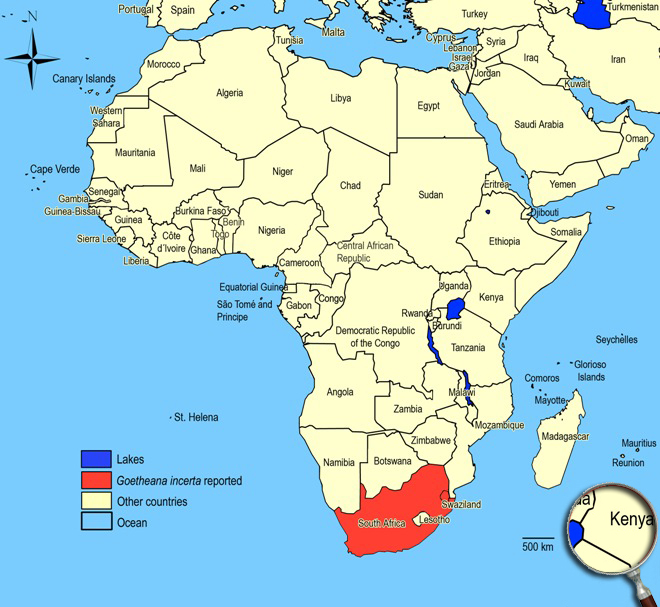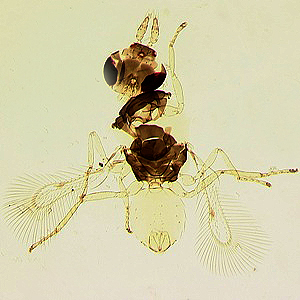Goetheana incerta Annecke, 1962
Entedoninae, Eulophidae, Chalcidoidea, Hymenoptera
Figures
Fig. 1: Head, mesosoma and metasoma, dorsal
Fig. 2: Head, mesosoma and metasoma, dorsal
Fig. 3: Antennae and head of female
Fig. 4: Funicle segment F2 and clava of antenna
Fig. 5: Funicle segments and basal segment of antennal clava
Fig. 6: Head dorsal with vertexal suture
Fig. 7: Mesosoma dorsal with mesoscutum and scutellum
Fig. 8: Fore wing
Fig. 9: Metasoma
Fig. 10: Petiole
Fig. 11: Antenna of male
Introduction and recognition
Goetheana incerta is a larval endoparasitoid of the thrips species Scirtothrips aurantii and Scirtothrips citri (familiy Thripidae). Female: length 0.5-0.6 mm. Head and mesosoma dark brown; antennae, legs and gaster uniformly pale yellowish (Fig. 1 and 2). Head with a complete and straight occipital suture across vertex just behind posterior ocelli (Fig. 3 and 6). Antenna with scape slender and about 4 x as long as wide; antennal flagellum with 2 funicle segments; F1 much smaller than F2, the latter superficially appears to be a part of clava; F1 without a sensillum, F2 with 1 long sensillum, both with many setae; 3-segmented clava about 2.2 x as long as wide, first claval segment wider than long, second a little longer than wide, third much longer than wide, usually with an apical spicula (Fig. 3, 4 and 5). Mesosoma about as long as gaster (Fig. 1 and 2), almost smooth; midlobe of mesoscutum without setae; anterior margin of scutellum straight (Fig. 7). Fore wing very narrow, recurved along posterior margin, nearly parallel-sided below marginal vein, 5.0 to 5.5 x as long as wide; longest marginal setae 1.8 to 2.0 x as long as maximal width of fore wing; disc hyaline, with numerous setae commencing beyond base of marginal vein and scattered in 2 or 3 broken rows toward the apex of the wing (Fig. 8). Hind wing slender, 18 to 20 x as long as wide; longest marginal setae 6 to 7 x as long as wing's maximal width. Petiole much wider than long (Fig. 10). Ovipositor very short, occupying about 1/3 length of gaster, not exerted.
Male similar to female, with scape slender (about 4.0 to 4.5 x as long as wide, not swollen) (Fig. 11).
Taxonomic identity
Species
Goetheana incerta Annecke, 1962
Taxonomic history
-
Present taxonomic position
Order: Hymenoptera
Superfamily: Chalcidoidea Latreille, 1817
Family: Eulophidae Westwood, 1829
Subfamily: Entedoninae Förster, 1856
Genus: Goetheana Girault, 1920
Genus description
The Genus Goetheana Girault, 1920
This genus comprises 4 described species. All known species of Goetheana are solitary, internal parasitoids of the larval stages of various Thripidae (Terebrantia), and are known from the Oriental, Australian, Ethiopian, and Neotropical regions. All species of this genus have the following features: Body size very small (less than 0.8 mm); head with a complete and straight occipital suture across vertex just behind posterior ocelli; mandible reduced and without teeth; antennal flagellum in both sexes with 2 funicle segments (F1 much smaller than F2, the latter superficially appears to be a part of clava), clava 3-segmented, usually with an apical spicula; scape of male antenna notably swollen in the majority of described species; notauli very narrow but distinct in slide-mounted specimens; midlobe of mesoscutum without setae; fore wing recurved along posterior margin, nearly parallel-sided below marginal vein, length of marginal setae exceeds width of fore wing; petiole much wider than long (Schauff 1991; Triapitsyn 2005). Gahan (1927) gave good descriptions and illustrations of two species, Goetheana incerta and Goetheana shakespearei, and Triapitsyn (2005) gave a world taxonomic revision of Goetheana and three other related entedonine genera of thrips parasitoids. Furthermore Loomans & van Lenteren (1995) provided an overview of the described thrips parasitoids and their importance for biological control of thrips pests.
Species description
Typical character states of Goetheana incerta
Body colour
Bicoloured
Antennae
Funicle segments F1 and F2: F1 much smaller than F2, F2 almost fused with clava
Length of scape in male: 4.0 to 4.5 x as long as wide, not swollen
Sensilla of funicle segments: F1 without a sensillum, F2 with 1 long sensillum
Length of funicle segments: about as long as wide or wider than long
Clava of female: 3-segmented
Apical spicula of clava: present
Head
Vertexal suture: straight
Frontal grooves: reaching eyes
above level of median ocellus, sometimes ending in vertexal suture
Mesosoma
Number of setal pairs on midlobe of mesoscutum: 0
Anterior margin of scutellum: straight
or slightly curved
Wings
Shape of fore wing: recurved along posterior margin, nearly parallel sided below marginal vein
Length of fore wing: 5.0 to 6.5 x as long as wide
Length of fore wing marginal setae: usually much greater than width of fore wing
Longest marginal setae of fore wing: about 2 x as long as maximal width of fore wing
Fore wing disc: with numerous setae commencing beyond base of marginal vein and scattered in 2 or 3 broken rows toward the apex of wing
Colour of fore wing disc: completely hyaline, without pigmentation
Metasoma
Colour of gaster: completely pale or yellow
Petiole: notably and about 2 x wider than long

Similar or related species
Female of Goetheana incerta is very similar to that of Goetheana shakespearei. Both may be distinguished only with difficulty: in Goetheana incerta the fore wings are shorter and smaller (5.0 to 5.5 x as long as wide) than in Goetheana shakespearei (5.5 to 6.5 x as long as wide), and the gaster is uniformly pale (in shakespearei sometimes the last 2 or 3 abdominal sclerites dorsally and laterally shaded). But male of Goetheana incerta differs from Goetheana shakespearei in having a slender antennal scape (4.0 to 4.5 x as long as wide, not swollen), similar to female of Goetheana incerta. Whereas in Goetheana shakespearei the scape of male antenna is extremely swollen, 1.0 to 1.3 x as long as wide.
Goetheana differs from other entedonine genera by the shape of the antennal funicle segments (in Goetheana funicle segment F1 much smaller than F2, F2 almost fused with clava; in other genera the funicle segments F1 and F2 are subequal), the shape of the fore wing (narrow and recurved below the submarginal vein in Goetheana; species of the genera Entedonomphale, Ceranisus and Thripobius with fore wings broadened beyond submarginal vein), and the length of marginal seta of fore wing (in Goetheana the longest marginal setae is much greater than width of fore wing; species of other genera with longest marginal setae at most equal to width of fore wing, but usually much less than width of fore wing). The chaetotaxy of the fore wing disc differs in the genera: in Goetheana the setae commencing beyond base of marginal vein and scattered in 2 or 3 broken rows toward the apex of the wing, in Entedonomphale the fore wing is evenly setose in apical half and bare in basal half, and in Ceranisus and Thripobius the fore wing is uniformly setose beyond base of marginal vein except for a bare area at posterior margin behind base of marginal vein, which is demarcated anteriorly by a sinuate or straight line of setae. Compared to species of Ceranisus with 2-segmented and Entedonomphale with unsegmented antennal clava, species of Goetheana as well as species of Thripobius have a 3-segmented antennal clava.
Biology
Life history
The life cycle of this parasitoid ranged from 21 - 25 days at 23°C and the pupal period was for 12-14 days. The parasitism rates of the thrips Scirtothrips aurantii was 2% in the months of February to March in South Africa (Grout & Stephen 1995).
Major host genera/species
Goetheana incerta has been recorded from South African citrus thrips Scirtothrips aurantii and Californian citrus thrips Scirtothrips citri.
Biological control
Several attempts to import and establish this parasitoid from South Africa into California for the management of Avocado thrips, Scirtothrips perseae were undertaken between 1997 to 1999, but those were not successful (Morse 1999).
Additional notes
-
Biogeography
South Africa (KwaZulu-Natal: Pietermaritzburg; Mpumalanga: Nelspruit; Limpopo: Skukuza - Kruger National Park), Swaziland.
African countries where Goetheana incerta has been reported

The species Goetheana incerta was not observed in surveys undertaken in East Africa on vegetables and associated weeds and crops.
Please click here for survey sites of all observed thrips species of Kenya, Tanzania and Uganda.

Bibliography
Annecke DP (1962). The genus Goetheana Girault in South Africa (Eulophidae-Hymenoptera). South African Journal of Agricultural Science. 5 (2): 273-279
Bouček Z Z (1976). Taxonomic studies on some Eulophidae [Hym.] of economic interest mainly from Africa. Entomophaga. 21 (4): 401-414
Gahan AB (1928). Miscellaneous descriptions of new parasitic Hymenoptera with some synonymical notes. Proceedings of the United States National Museum. 71 (4): 1-40
Gibson, G.A.P., Read, J.D. & Fairchild, R. 1998. Chalcid wasps (Chalcidoidea): illustrated glossary of positional and morphological terms
Grout TG & Stephen PR (1995). Goetheana incerta parasitizing citrus thrips in southern Africa. Citrus Journal. 5 (4): 30-32
Loomans AJM, Murai T & Green ID (1997). Interactions with hymenopterous parasitoids and parasitic nematodes, pp. 355-397. In Lewis T [ed.], Thrips as crop pests. CAB International, Wallingford, Oxon, UK
Loomans AJM & van Lenteren JC (1995). Biological control of thrips pests: a review on thrips parasitoids, pp. 89-201. In Loomans AJM, van Lenteren JC, Tommasini MG, Maini S & Riudavets J [eds.], Biological control of thrips pests. Wageningen Agricultural University Papers, 95-1. Veenman Drukkers, Wageningen, The Netherlands
Morse J (1998). Avocado thrips subproject 3: Pesticide screening, sabadilla
resistance monitoring, and Goetheana incerta studies. 1998 California Avocado Research Symposium, pp. 23-25. California Avocado Society and University of California, Riverside http://www.avocadosource.com/ARAC/SUM_1998/SYMP_1998_PG_23-25.pdf
Morse J (1999). Avocado thrips subproject 3:
Pesticide screening, sabadilla resistance, Goetheana and
lacewing studies. 1999 California Avocado Research Symposium, pp. 37-46.
California Avocado Society and University of California, Riverside http://www.avocadosource.com/ARAC/SUM_1999/SYMP_1999_PG_37-46.pdf
Schauff M (1991). The Holarctic genera of Entedoninae (Hymenoptera: Eulophidae). Contributions of the American Entomological Institute. 26 (4): 1-109
Triapitsyn SV (2005). Revision of Ceranisus and the related thrips-attacking entedonine genera (Hymenoptera: Eulophidae) of the world. African Invertebrates. 46: 261-315
----
Web links
BMNH, Universal Chalcidoidea Database
UC Riverside - Key to the Nearctic genera of Eulophidae
Mound´s Thysanoptera pages
Thysanoptera Checklist
ICIPE Thrips survey sites
UNI Halle & Thrips sites
Thrips of California
Chalcid wasps (Chalcidoidea): illustrated glossary of positional and morphological terms
Assembling the Tree of Life - Hymenopera Glossary














